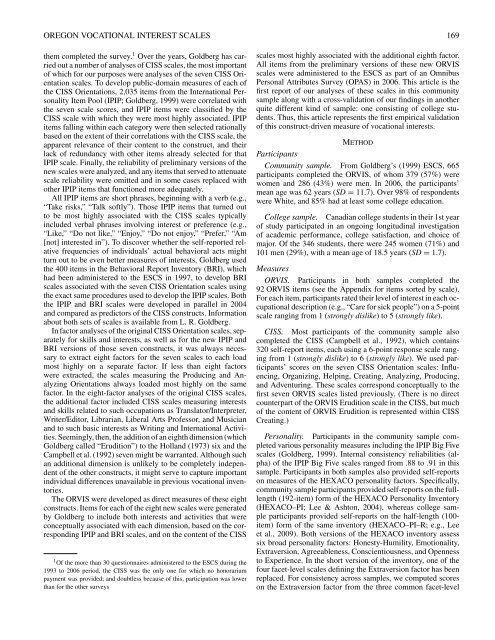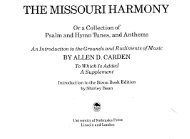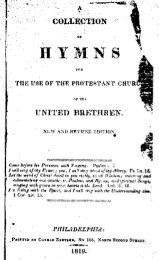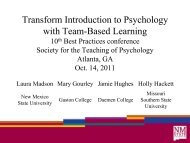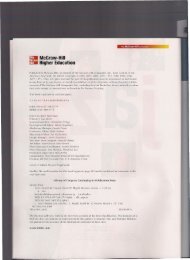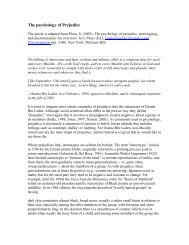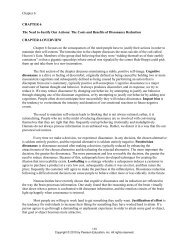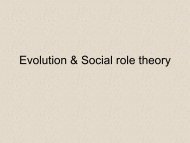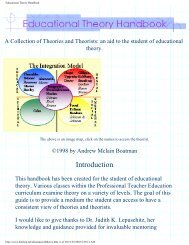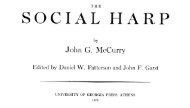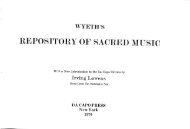Pozzebon et al.,2010
Pozzebon et al.,2010
Pozzebon et al.,2010
You also want an ePaper? Increase the reach of your titles
YUMPU automatically turns print PDFs into web optimized ePapers that Google loves.
OREGON VOCATIONAL INTEREST SCALES 169<br />
them compl<strong>et</strong>ed the survey. 1 Over the years, Goldberg has carried<br />
out a number of an<strong>al</strong>yses of CISS sc<strong>al</strong>es, the most important<br />
of which for our purposes were an<strong>al</strong>yses of the seven CISS Orientation<br />
sc<strong>al</strong>es. To develop public-domain measures of each of<br />
the CISS Orientations, 2,035 items from the Internation<strong>al</strong> Person<strong>al</strong>ity<br />
Item Pool (IPIP; Goldberg, 1999) were correlated with<br />
the seven sc<strong>al</strong>e scores, and IPIP items were classified by the<br />
CISS sc<strong>al</strong>e with which they were most highly associated. IPIP<br />
items f<strong>al</strong>ling within each category were then selected ration<strong>al</strong>ly<br />
based on the extent of their correlations with the CISS sc<strong>al</strong>e, the<br />
apparent relevance of their content to the construct, and their<br />
lack of redundancy with other items <strong>al</strong>ready selected for that<br />
IPIP sc<strong>al</strong>e. Fin<strong>al</strong>ly, the reliability of preliminary versions of the<br />
new sc<strong>al</strong>es were an<strong>al</strong>yzed, and any items that served to attenuate<br />
sc<strong>al</strong>e reliability were omitted and in some cases replaced with<br />
other IPIP items that functioned more adequately.<br />
All IPIP items are short phrases, beginning with a verb (e.g.,<br />
“Take risks,” “T<strong>al</strong>k softly”). Those IPIP items that turned out<br />
to be most highly associated with the CISS sc<strong>al</strong>es typic<strong>al</strong>ly<br />
included verb<strong>al</strong> phrases involving interest or preference (e.g.,<br />
“Like,” “Do not like,” “Enjoy,” “Do not enjoy,” “Prefer,” “Am<br />
[not] interested in”). To discover wh<strong>et</strong>her the self-reported relative<br />
frequencies of individu<strong>al</strong>s’ actu<strong>al</strong> behavior<strong>al</strong> acts might<br />
turn out to be even b<strong>et</strong>ter measures of interests, Goldberg used<br />
the 400 items in the Behavior<strong>al</strong> Report Inventory (BRI), which<br />
had been administered to the ESCS in 1997, to develop BRI<br />
sc<strong>al</strong>es associated with the seven CISS Orientation sc<strong>al</strong>es using<br />
the exact same procedures used to develop the IPIP sc<strong>al</strong>es. Both<br />
the IPIP and BRI sc<strong>al</strong>es were developed in par<strong>al</strong>lel in 2004<br />
and compared as predictors of the CISS constructs. Information<br />
about both s<strong>et</strong>s of sc<strong>al</strong>es is available from L. R. Goldberg.<br />
In factor an<strong>al</strong>yses of the origin<strong>al</strong> CISS Orientation sc<strong>al</strong>es, separately<br />
for skills and interests, as well as for the new IPIP and<br />
BRI versions of those seven constructs, it was <strong>al</strong>ways necessary<br />
to extract eight factors for the seven sc<strong>al</strong>es to each load<br />
most highly on a separate factor. If less than eight factors<br />
were extracted, the sc<strong>al</strong>es measuring the Producing and An<strong>al</strong>yzing<br />
Orientations <strong>al</strong>ways loaded most highly on the same<br />
factor. In the eight-factor an<strong>al</strong>yses of the origin<strong>al</strong> CISS sc<strong>al</strong>es,<br />
the addition<strong>al</strong> factor included CISS sc<strong>al</strong>es measuring interests<br />
and skills related to such occupations as Translator/Interpr<strong>et</strong>er,<br />
Writer/Editor, Librarian, Liber<strong>al</strong> Arts Professor, and Musician<br />
and to such basic interests as Writing and Internation<strong>al</strong> Activities.<br />
Seemingly, then, the addition of an eighth dimension (which<br />
Goldberg c<strong>al</strong>led “Erudition”) to the Holland (1973) six and the<br />
Campbell <strong>et</strong> <strong>al</strong>. (1992) seven might be warranted. Although such<br />
an addition<strong>al</strong> dimension is unlikely to be compl<strong>et</strong>ely independent<br />
of the other constructs, it might serve to capture important<br />
individu<strong>al</strong> differences unavailable in previous vocation<strong>al</strong> inventories.<br />
The ORVIS were developed as direct measures of these eight<br />
constructs. Items for each of the eight new sc<strong>al</strong>es were generated<br />
by Goldberg to include both interests and activities that were<br />
conceptu<strong>al</strong>ly associated with each dimension, based on the corresponding<br />
IPIP and BRI sc<strong>al</strong>es, and on the content of the CISS<br />
1 Of the more than 30 questionnaires administered to the ESCS during the<br />
1993 to 2006 period, the CISS was the only one for which no honorarium<br />
payment was provided; and doubtless because of this, participation was lower<br />
than for the other surveys<br />
sc<strong>al</strong>es most highly associated with the addition<strong>al</strong> eighth factor.<br />
All items from the preliminary versions of these new ORVIS<br />
sc<strong>al</strong>es were administered to the ESCS as part of an Omnibus<br />
Person<strong>al</strong> Attributes Survey (OPAS) in 2006. This article is the<br />
first report of our an<strong>al</strong>yses of these sc<strong>al</strong>es in this community<br />
sample <strong>al</strong>ong with a cross-v<strong>al</strong>idation of our findings in another<br />
quite different kind of sample: one consisting of college students.<br />
Thus, this article represents the first empiric<strong>al</strong> v<strong>al</strong>idation<br />
of this construct-driven measure of vocation<strong>al</strong> interests.<br />
METHOD<br />
Participants<br />
Community sample. From Goldberg’s (1999) ESCS, 665<br />
participants compl<strong>et</strong>ed the ORVIS, of whom 379 (57%) were<br />
women and 286 (43%) were men. In 2006, the participants’<br />
mean age was 62 years (SD = 11.7). Over 98% of respondents<br />
were White, and 85% had at least some college education.<br />
College sample. Canadian college students in their 1st year<br />
of study participated in an ongoing longitudin<strong>al</strong> investigation<br />
of academic performance, college satisfaction, and choice of<br />
major. Of the 346 students, there were 245 women (71%) and<br />
101 men (29%), with a mean age of 18.5 years (SD = 1.7).<br />
Measures<br />
ORVIS. Participants in both samples compl<strong>et</strong>ed the<br />
92 ORVIS items (see the Appendix for items sorted by sc<strong>al</strong>e).<br />
For each item, participants rated their level of interest in each occupation<strong>al</strong><br />
description (e.g., “Care for sick people”) on a 5-point<br />
sc<strong>al</strong>e ranging from 1 (strongly dislike)to5(strongly like).<br />
CISS. Most participants of the community sample <strong>al</strong>so<br />
compl<strong>et</strong>ed the CISS (Campbell <strong>et</strong> <strong>al</strong>., 1992), which contains<br />
320 self-report items, each using a 6-point response sc<strong>al</strong>e ranging<br />
from 1 (strongly dislike) to6(strongly like). We used participants’<br />
scores on the seven CISS Orientation sc<strong>al</strong>es: Influencing,<br />
Organizing, Helping, Creating, An<strong>al</strong>yzing, Producing,<br />
and Adventuring. These sc<strong>al</strong>es correspond conceptu<strong>al</strong>ly to the<br />
first seven ORVIS sc<strong>al</strong>es listed previously. (There is no direct<br />
counterpart of the ORVIS Erudition sc<strong>al</strong>e in the CISS, but much<br />
of the content of ORVIS Erudition is represented within CISS<br />
Creating.)<br />
Person<strong>al</strong>ity. Participants in the community sample compl<strong>et</strong>ed<br />
various person<strong>al</strong>ity measures including the IPIP Big Five<br />
sc<strong>al</strong>es (Goldberg, 1999). Intern<strong>al</strong> consistency reliabilities (<strong>al</strong>pha)<br />
of the IPIP Big Five sc<strong>al</strong>es ranged from .88 to .91 in this<br />
sample. Participants in both samples <strong>al</strong>so provided self-reports<br />
on measures of the HEXACO person<strong>al</strong>ity factors. Specific<strong>al</strong>ly,<br />
community sample participants provided self-reports on the fulllength<br />
(192-item) form of the HEXACO Person<strong>al</strong>ity Inventory<br />
(HEXACO–PI; Lee & Ashton, 2004), whereas college sample<br />
participants provided self-reports on the h<strong>al</strong>f-length (100item)<br />
form of the same inventory (HEXACO–PI–R; e.g., Lee<br />
<strong>et</strong> <strong>al</strong>., 2009). Both versions of the HEXACO inventory assess<br />
six broad person<strong>al</strong>ity factors: Honesty-Humility, Emotion<strong>al</strong>ity,<br />
Extraversion, Agreeableness, Conscientiousness, and Openness<br />
to Experience. In the short version of the inventory, one of the<br />
four fac<strong>et</strong>-level sc<strong>al</strong>es defining the Extraversion factor has been<br />
replaced. For consistency across samples, we computed scores<br />
on the Extraversion factor from the three common fac<strong>et</strong>-level


